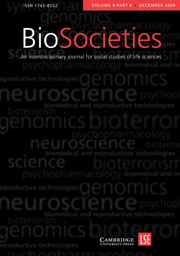Crossref Citations
This article has been cited by the following publications. This list is generated based on data provided by
Crossref.
Hashiloni-Dolev, Yael
2006.
BETWEEN MOTHERS, FETUSES AND SOCIETY: REPRODUCTIVE GENETICS IN THE ISRAELI-JEWISH CONTEXT.
Nashim: A Journal of Jewish Women's Studies & Gender Issues,
Vol. 12,
Issue. ,
p.
129.
Sleeboom-Faulkner, Margaret
2007.
Social-science Perspectives on Bioethics: Predictive Genetic Testing (PGT) in Asia.
Journal of Bioethical Inquiry,
Vol. 4,
Issue. 3,
p.
197.
Hashiloni-Dolev, Yael
and
Shkedi, Shiri
2007.
On new reproductive technologies and family ethics: Pre-implantation genetic diagnosis for sibling donor in Israel and Germany.
Social Science & Medicine,
Vol. 65,
Issue. 10,
p.
2081.
Leavitt, Frank J
2007.
Encyclopedia of Life Sciences.
Prainsack, Barbara
2007.
Research populations: biobanks in Israel.
New Genetics and Society,
Vol. 26,
Issue. 1,
p.
85.
Raz, Aviad E.
and
Vizner, Yafa
2008.
Carrier matching and collective socialization in community genetics: Dor Yeshorim and the reinforcement of stigma.
Social Science & Medicine,
Vol. 67,
Issue. 9,
p.
1361.
Jacob, Marie-Andrée
2009.
The Shared History: Unknotting Fictive Kinship and Legal Process.
Law & Society Review,
Vol. 43,
Issue. 1,
p.
95.
Freese, Jeremy
and
Shostak, Sara
2009.
Genetics and Social Inquiry.
Annual Review of Sociology,
Vol. 35,
Issue. 1,
p.
107.
Tamhankar, Parag M.
Agarwal, Sarita
Arya, Vandana
Kumar, Ravindra
Gupta, U. R.
and
Agarwal, S. S.
2009.
Prevention of homozygous beta thalassemia by premarital screening and prenatal diagnosis in India.
Prenatal Diagnosis,
Vol. 29,
Issue. 1,
p.
83.
Soffer, Y.
and
Birenbaum-Carmeli, D.
2010.
Donner et après....
p.
17.
Raz, Aviad E.
2010.
Commentary: a sociologist's view on community genetics.
Journal of Community Genetics,
Vol. 1,
Issue. 1,
p.
3.
Soffer, Y.
and
Birenbaum-Carmeli, D.
2010.
Le don de sperme en Israël, son secret et son anonymat.
Basic and Clinical Andrology,
Vol. 20,
Issue. 1,
p.
11.
Soffer, Y.
and
Birenbaum-Carmeli, D.
2010.
Le don de sperme en Israël, son secret et son anonymat.
Basic and Clinical Andrology,
Vol. 20,
Issue. 1,
p.
11.
Al-Aama, Jumana Y.
2010.
Attitudes towards mandatory national premarital screening for hereditary hemolytic disorders.
Health Policy,
Vol. 97,
Issue. 1,
p.
32.
Gibbon, Sahra
Kampriani, Eirini
and
Nieden, Andrea zur
2010.
BRCA patients in Cuba, Greece and Germany: Comparative perspectives on public health, the state and the partial reproduction of ‘neoliberal’ subjects.
BioSocieties,
Vol. 5,
Issue. 4,
p.
440.
Frumkin, Ayala
Raz, Aviad E.
Plesser-Duvdevani, Morasha
and
Lieberman, Sari
2011.
"The Most Important Test You’ll Ever Take"?: Attitudes toward confidential carrier matching and open individual testing among modern-religious Jews in Israel.
Social Science & Medicine,
Vol. 73,
Issue. 12,
p.
1741.
Pollak, Shulamis Juni
2011.
Correlates of Genetic Counseling and Testing Among Orthodox Jews.
Journal of Religion and Health,
Vol. 50,
Issue. 4,
p.
796.
Teman, Elly
Ivry, Tsipy
and
Bernhardt, Barbara A.
2011.
Pregnancy as a proclamation of faith: Ultra‐Orthodox Jewish women navigating the uncertainty of pregnancy and prenatal diagnosis.
American Journal of Medical Genetics Part A,
Vol. 155,
Issue. 1,
p.
69.
Valkenburg, Govert
and
Aarden, Erik
2011.
Constructing embryos, constructing politics: Connecting politics and technology in the Netherlands and Germany.
BioSocieties,
Vol. 6,
Issue. 4,
p.
447.
Teman, Elly
Ivry, Tsipy
and
Bernhardt, Barbara A.
2012.
Pregnancy as a Proclamation of Faith: Ultra-Orthodox Jewish Women Navigating the Uncertainty of Pregnancy and Prenatal Diagnosis.
SSRN Electronic Journal,


